Physical Address
304 North Cardinal St.
Dorchester Center, MA 02124
Significant advances have been made in the treatment of ischemic cardiomyopathy; however the presence of mitral regurgitation in this population continues to be a significant risk factor for mortality. This chapter addresses the current concepts regarding the pathophysiology, decision making, and treatment of ischemic mitral regurgitation.
Carpentier's pathophysiologic triad is our preferred approach for defining ischemic mitral regurgitation. Most of the clinical literature on ischemic mitral regurgitation remains difficult to interpret because imprecise definitions are often applied, which leads to marked heterogeneity within and between patient populations. A precise and uniform definition of ischemic mitral regurgitation is critical to the presentation of a relatively homogeneous group of patients for analysis and treatment. A strict definition of ischemic regurgitation according to the pathophysiologic triad typically requires the following:
The etiology in this process is ischemic heart disease. This typically requires demonstration of coronary artery atherosclerosis and evidence of prior myocardial infarction with regional or global dysfunction or dilation of the left ventricle.
The primary lesion causing regurgitation seen on echocardiography is tethering of the valve leaflets.
The primary resulting valve dysfunction is mitral regurgitation caused by restriction of leaflet motion, which occurs mainly in systole (Carpentier's type IIIB dysfunction).
Although annular dilation often coexists in chronic ischemic regurgitation, this is usually the secondary, rather than primary, lesion. Ischemic mitral regurgitation with normal unrestricted leaflet motion (Carpentier type I dysfunction) can occur in the setting of a basal infarction, but such cases are infrequent. The infrequently encountered scenario where an infarcted papillary muscle elongates to cause leaflet prolapse (Carpentier type II dysfunction) is a rare form of ischemic mitral regurgitation and is considered briefly at the end of this chapter. When prolapse is seen in patients with ischemic heart disease, the more likely explanation is degenerative, rather than ischemic, etiology. A true type IIIA dysfunction (leaflet restriction in both systole and diastole) is not seen in ischemic mitral regurgitation. If a chronic type II or IIIB dysfunction is seen in a patient with ischemic heart disease, the surgeon must consider nonischemic etiologies: this distinction is important, because the therapy for ischemic mitral regurgitation—a downsized annuloplasty—can be potentially harmful if applied to patients with a type II or IIIA dysfunction if they are misclassified as having ischemic mitral regurgitation ( Fig. 92-1 ).
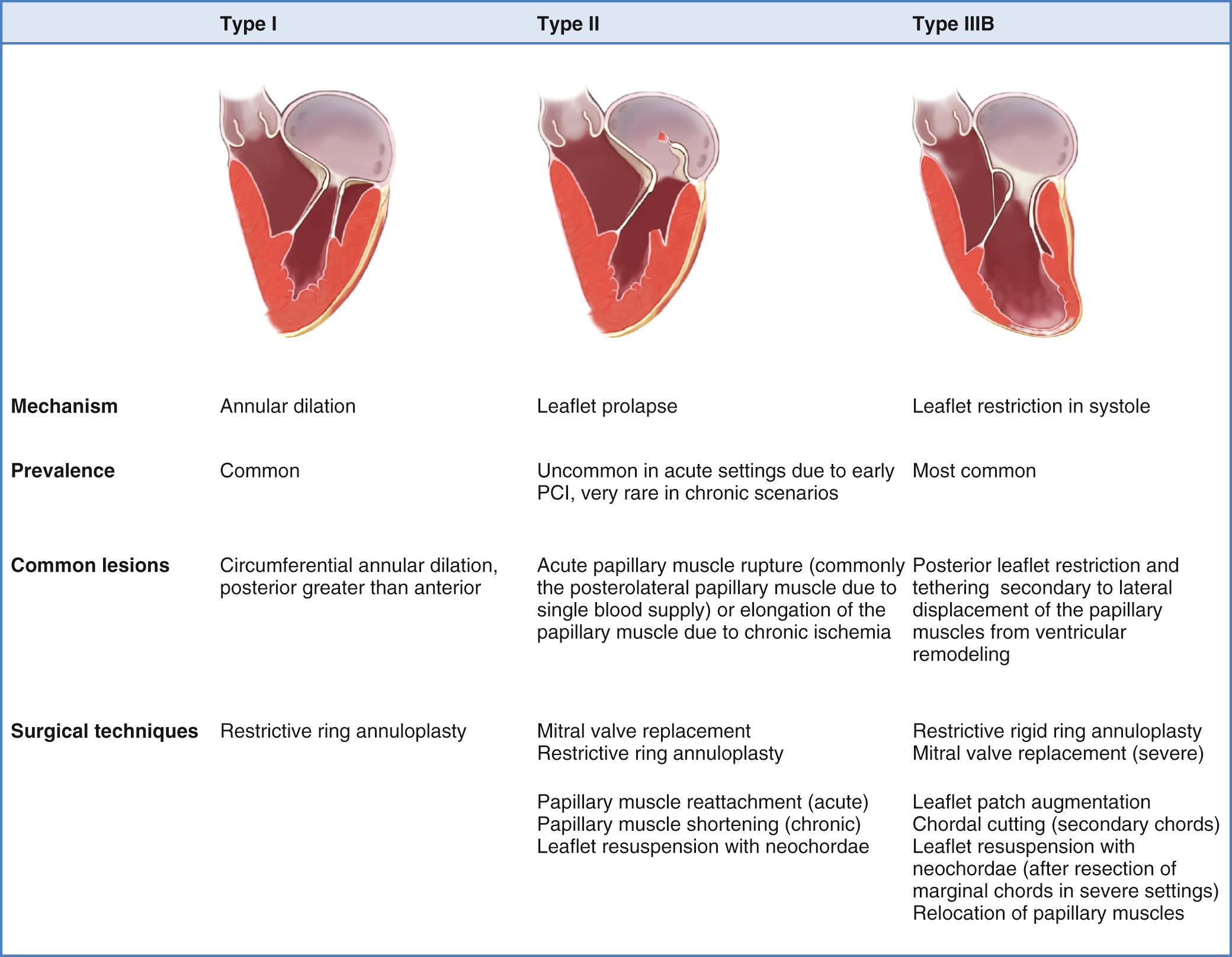
The majority of patients with ischemic mitral regurgitation have so-called functional ischemic mitral regurgitation from IIIB dysfunction without any leaflet or subvalvular lesions (leaflet tethering occurring because of papillary muscle displacement). Although the term functional mitral regurgitation is commonly used to refer to mitral regurgitation without “organic” lesions of the mitral valve, its use should be discouraged, because it is an imprecise term and lacks the mechanistic and therapeutic correlates of the Carpentier functional classification. Furthermore, although it is often assumed that the valve apparatus is normal in functional regurgitation, pathologic studies have shown that these leaflets are thinned out with altered collagen composition compared with autopsy controls. Secondary mitral valve regurgitation is a more appropriate term because it differentiates mitral regurgitation due to secondary ventricular process, from that due to primary pathology of the valve leaflets or subvalvular apparatus.
A documented clinical history of a myocardial infarction (MI) is not mandatory for the diagnosis of ischemic mitral regurgitation. Although a prior MI is almost always present in these patients, it may be silent in many patients, especially in those with diabetes. In addition, the spectrum of ischemic mitral regurgitation likely includes a small number of patients with large areas of ischemic hibernating myocardium (without substantial infarction), causing papillary muscle displacement and type IIIB mitral regurgitation. However, for practical purposes, in this chapter we will assume (unless otherwise stated) that all patients have infarction-induced ventricular remodeling, as true ischemic mitral regurgitation without underlying infarction is not rare.
The optimal way to evaluate ischemic mitral regurgitation is by semiquantitative or quantitative assessment, preferably by transthoracic echocardiography performed while the patient is awake and not actively ischemic. General anesthesia and even the light sedation required for transesophageal echocardiography (TEE) can unload the ventricle and lead to underestimation of the degree of mitral regurgitation. In addition, the potential unloading effects of inotropes, vasodilators, and intra-aortic balloon pump can affect the degree of regurgitation. During the past two decades, state-of-the-art techniques for quantifying mitral regurgitation by echocardiography have emerged, and they are particularly useful for patients with ischemic regurgitation. The recommended method to measure the degree of the mitral regurgitation quantitatively is to calculate the regurgitant volume and the effective regurgitant orifice using the flow-convergence proximal isovelocity surface area method. These calculations along with evaluating for hemodynamic consequences of the regurgitation most accurately define the severity of the mitral regurgitation. The Mayo group has suggested that the thresholds for defining significant mitral regurgitation should be lower (regurgitant volume, ≥30 mL; effective regurgitant orifice area, ≥20 mm 2 ) in secondary (functional) mitral regurgitation than in primary (organic) mitral regurgitation, given its effect on survival in this group. Cine ventriculography has been superseded by echocardiography for diagnosis and grading of ischemic mitral regurgitation. The absence of mitral regurgitation on ventriculography should not be regarded as sufficient to exclude ischemic mitral regurgitation. This is increasingly important in the current era, as many interventionists have moved toward a low-volume injection technique for ventriculography, which is suboptimal for assessing mitral regurgitation.
Ischemic mitral regurgitation has traditionally been characterized as acute or chronic. Rarely, some patients develop acute mitral regurgitation during bouts of ischemia; this type disappears with the revascularization or resolution of the ischemia and is not considered in this chapter. Acute mitral regurgitation as a result of papillary muscle rupture after acute myocardial infarction is discussed at the end of this chapter. The vast majority of patients with ischemic regurgitation have a specific propensity to mitral regurgitation because of effects of prior myocardial infarction, effects that are generally permanent and chronic unless they are ameliorated surgically. In many patients, ischemic mitral regurgitation is asymptomatic and is an incidental finding at echocardiography. When regurgitation is severe or long-standing, or when the degree of accompanying left ventricular dysfunction is severe, patients present with symptoms and signs of heart failure.
Patients with type IIIB ischemic mitral regurgitation typically present with one of two clinical scenarios ( Fig. 92-2 ). The first scenario is a patient with symptomatic multivessel coronary artery disease, with or without associated congestive heart failure symptoms, who is referred for surgical or percutaneous revascularization and who is typically noted to have mild to moderate mitral regurgitation on preoperative or intraoperative imaging. The other scenario is a patient with moderate to severe mitral regurgitation and primarily congestive heart failure symptoms, who is referred for mitral valve surgery and who has significant coronary artery disease. Increasingly, patients in the latter group have undergone prior percutaneous or surgical revascularization. Associated coronary artery disease typically involves more than one vessel, but ischemic mitral regurgitation can also occur in the setting of single-vessel disease.
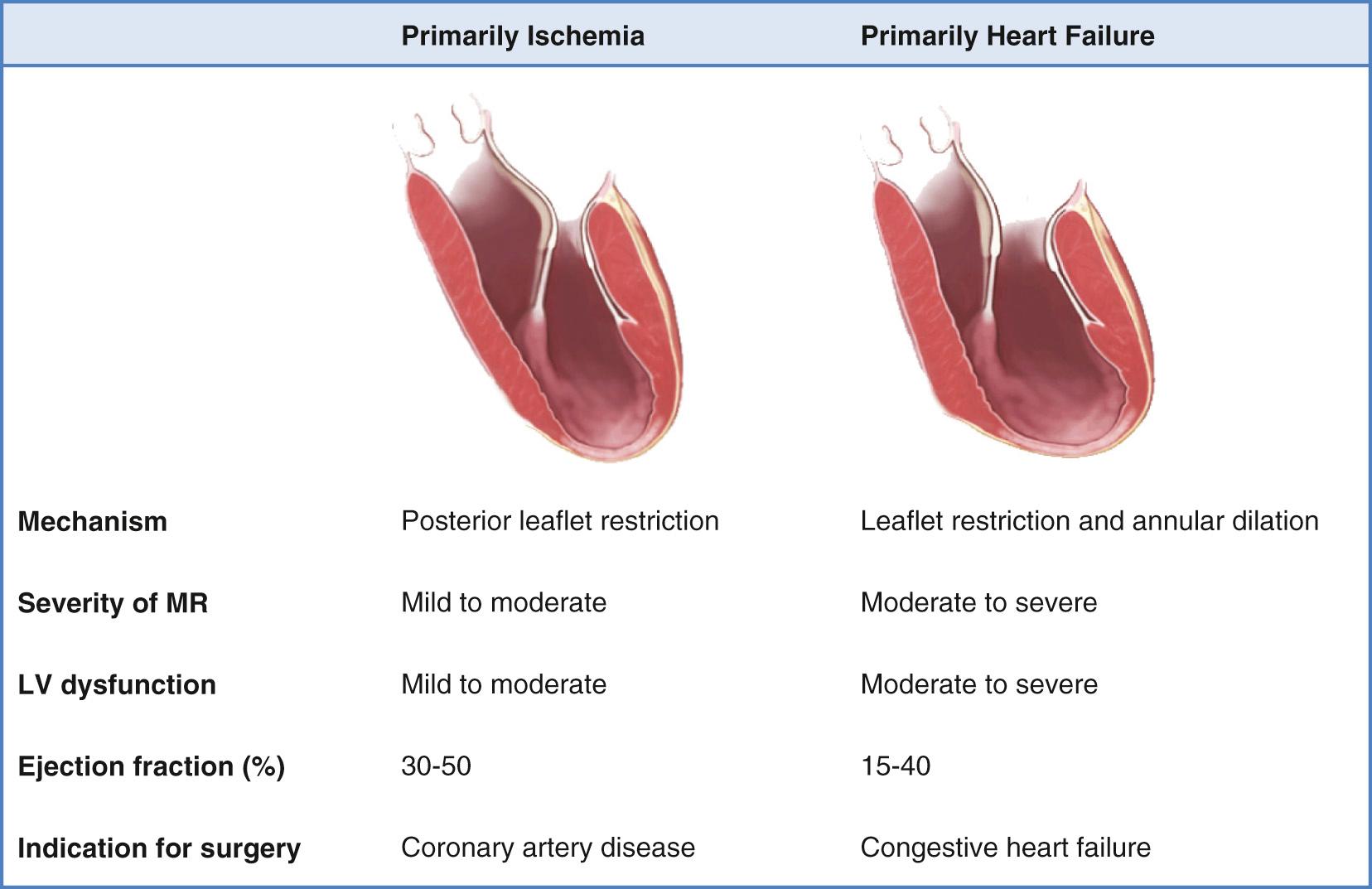
Normal mitral valve function involves a complex, three-dimensional interaction among the leaflets, the annulus, the subvalvular apparatus, and the left ventricle. The mechanism by which myocardial ischemia and infarction perturb this carefully orchestrated process has been the focus of intensive laboratory investigation. Several groups have carefully analyzed the geometric mechanisms of ischemic mitral regurgitation in large animal models using biplane fluoroscopy, sonomicrometry, and two- and three-dimensional echocardiography. Although these studies have several limitations, they provide significant insight into the pathophysiology of ischemic mitral regurgitation and potential treatment modalities.
The key pathophysiologic components of types I and IIIB ischemic mitral regurgitation include annular changes (dilation, distortion), subvalvular changes (papillary muscle displacement), and ventricular changes (dilation with increased sphericity, and wall motion abnormalities). Figure 92-3 provides an overview of how these components interact to result in poor leaflet coaptation, which is the final common pathway for all types of mitral regurgitation.
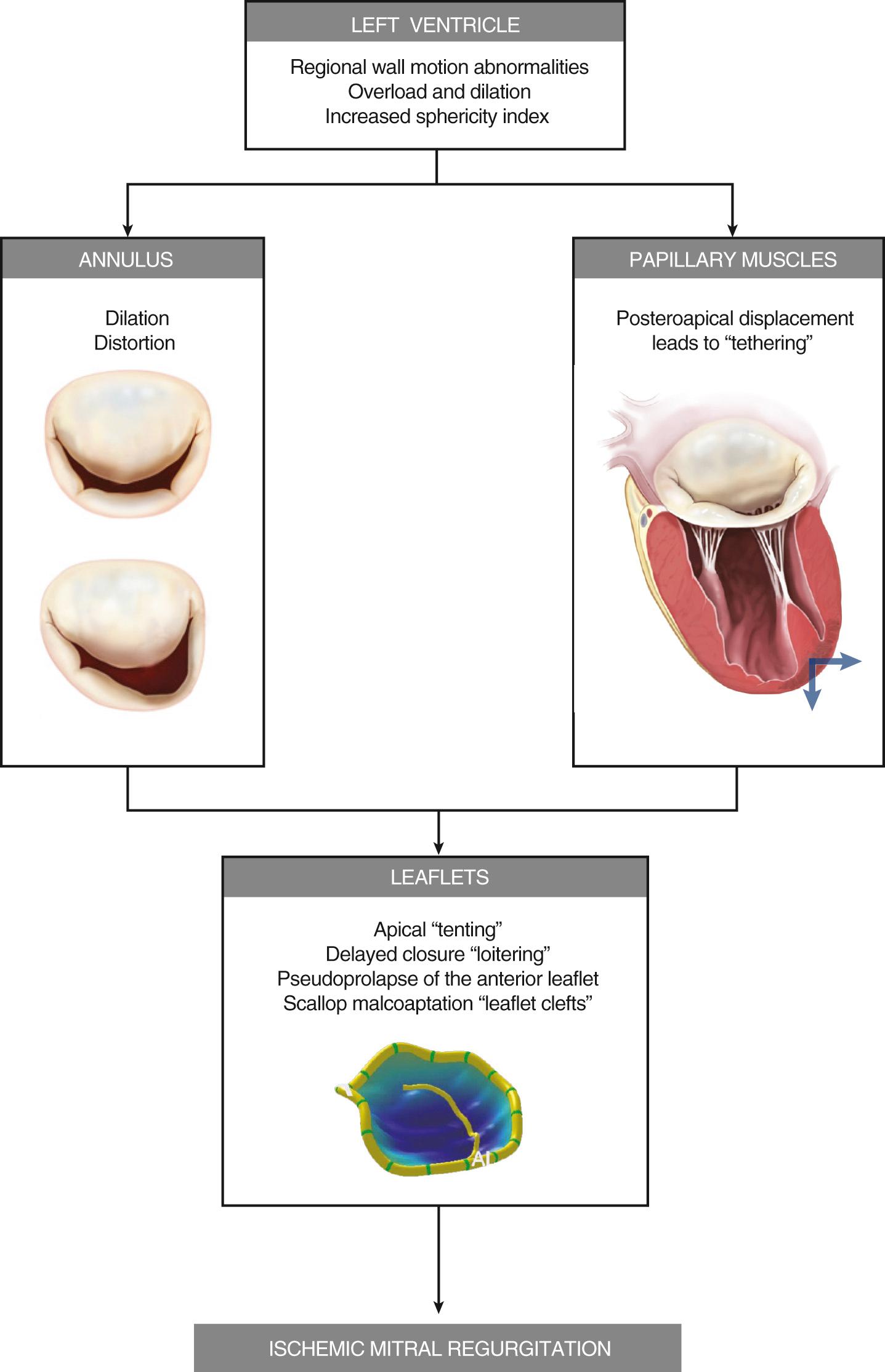
Although annular dilation is a common finding in clinical cases of chronic ischemic mitral regurgitation, the degree of dilation is often not severe and does not necessarily correlate with the degree of mitral regurgitation. Dilation of the annulus causes the leaflets to pull apart and hinders adequate leaflet coaptation. Although the posterior portion of the annulus is far more affected by ventricular or atrial enlargement, the anterior annulus has been shown to dilate as well. This concept has been demonstrated in both pathologic and imaging studies, which showed that although annular dilation is predominant in the region of the posterior commissure, it is often asymmetrically present throughout the annulus as well. Along with dilation, the annulus also flattens, losing its saddle shape, in ischemic mitral disease. The degree of annular dilation might not be a fundamental component of ischemic mitral regurgitation pathophysiology. Green and colleagues showed that in an acute sheep model, moderate degrees of annular dilation do not necessarily lead to ischemic mitral regurgitation. Timek and coworkers noted that the mild degrees of annular dilation that they observed during acute occlusion of the left anterior descending or distal left circumflex did not result in ischemic mitral regurgitation. This study, and several others from the same group, noted the critical role of the septolateral (SL) annular dimension in the pathophysiology and treatment of ischemic mitral regurgitation. The SL dimension—also referred to as the anteroposterior (AP) dimension—is the vertical or short axis of the annular ellipse that extends from the middle of the anterior annulus to the middle of the posterior annulus. The horizontal or long axis of the ellipse is referred to as the commissure-commissure (CC) dimension. Studies have shown that in the sheep acute ischemia model, an increase in mitral annular area causes mitral regurgitation only to the extent that it increases the SL dimension. Furthermore, these researchers also demonstrated the importance of the SL dimension by using a cinching device to diminish this dimension abolishing ischemic mitral regurgitation in sheep independent of overall annular circumference. Although the CC dimension does not usually increase significantly with ischemia, it has been shown to change proportionally with the change in the posterior annulus. This disproportionate posterior annular dilation accounts for the more significant increase in the SL dimension. In severe cases of ischemic mitral regurgitation, the SL dimension can approach the CC dimension, which results in a circular annulus rather than the normal ellipse.
Papillary muscle displacement also plays a critical role in the pathophysiology of ischemic mitral regurgitation. It is important to distinguish this from papillary muscle dysfunction (decreased or discoordinated papillary muscle systolic shortening), which had previously been thought to be the primary mechanism for ischemic mitral regurgitation. In fact, papillary muscle dysfunction does not necessarily result in ischemic mitral regurgitation. Timek and coworkers showed that the decreased shortening of one or both papillary muscles did not correlate with ischemic mitral regurgitation in the sheep. On the contrary, Messas and colleagues demonstrated a paradoxical decrease in ischemic mitral regurgitation with papillary muscle dysfunction.
The primary alteration in papillary muscle geometry leading to ischemic mitral regurgitation is papillary muscle displacement. The pattern of displacement is actually fairly complex and cannot simply be described as apical tethering. The papillary muscle tips are displaced away from the midseptal (anterior) annulus (i.e., posterolaterally, apically, and away from each other). The tethering distance has been shown experimentally to correlate with the severity of ischemic mitral regurgitation. Experimental studies suggest that although displacement of both papillary muscles is probably necessary to induce ischemic mitral regurgitation, displacement of the posteromedial papillary muscle group usually predominates.
The initiating insult in ischemic mitral regurgitation is ventricular, specifically myocardial ischemia or infarction with remodeling that leads to regional annular and subvalvular distortion and ultimately poor leaflet coaptation. The independent contribution of global ventricular size and shape to the pathophysiology of ischemic mitral regurgitation is less clear. In an echocardiographic study of 102 patients, Kumanohoso and coworkers showed that in comparison to those with anterior infarctions, patients with inferior infarctions had a higher incidence of ischemic mitral regurgitation despite less severe left ventricular dilation and dysfunction; this was directly attributed to more severe posteromedial papillary muscle tethering in the inferior infarction group. Experimental data, however, suggest that regional left ventricular dysfunction does not lead to ischemic mitral regurgitation without some degree of left ventricular dilation.
It appears that the left ventricular sphericity is more important than the actual ventricular volumes or ejection fraction in the pathophysiology of ischemic mitral regurgitation. Using three-dimensional echocardiography, several groups have shown that the mechanism of regurgitation differs according to the region of infarction. Watanabe and colleagues, for example, found that tethering was more localized and predominant in the medial posterior leaflet in patients with inferior infarction, compared with more widespread tethering of both leaflets in anterior infarction ( Fig. 92-4 ). This observation confirms the critical role of regional ventricular geometry and function in the pathophysiology of ischemic mitral regurgitation and helps to explain why some patients with only mildly impaired global ventricular function have severe ischemic mitral regurgitation. Song and colleagues found that an inferior infarction coexisting with an anterior wall infarct led to a more severe regurgitation, independent of ventricular volume. These observations suggest that geometry of the valve apparatus may be a more important determinant of regurgitation than left ventricular volume or ejection fraction. It is possible, therefore, to have severe ischemic mitral regurgitation in the setting of relatively preserved ventricular function. Tethering is more symmetrical in patients with coexisting inferior and anterior infarction.
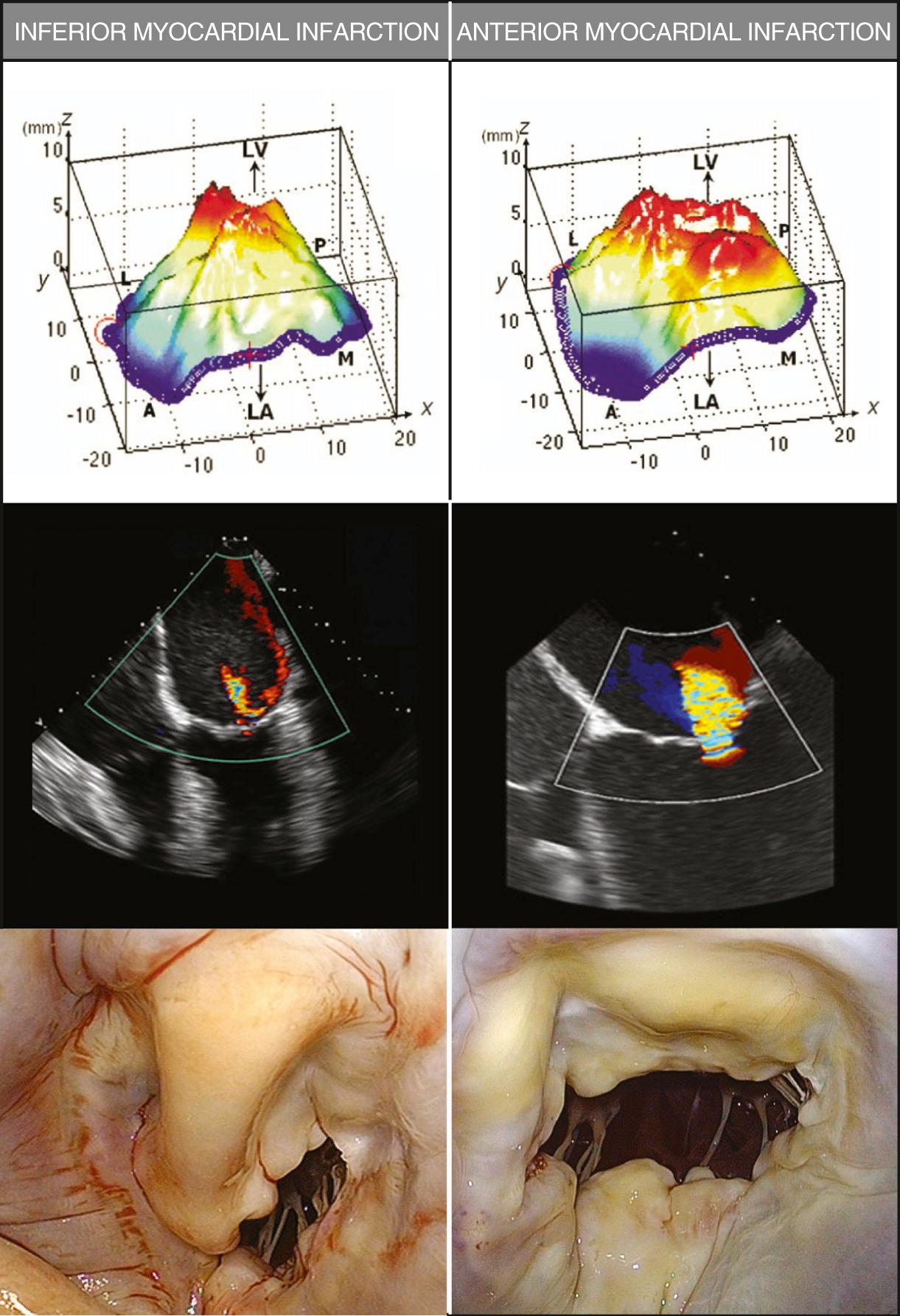
Papillary muscle tethering leads to apical tenting of the leaflets (restriction of the motion of the free margins of the leaflets), which prevents the free margins of the leaflets from rising to the plane of the annulus to coapt with one another. Tethering of the secondary chordae can result in an effet de mouette deformation of the body of the leaflet, which further impairs coaptation. Leaflet tethering is typically asymmetric in ischemic mitral regurgitation. The posteromedial side of the valve (A3 and P3) has more pronounced restriction when compared with the anterolateral side (A1 and P1). Malcoaptation of the scallops of the posterior leaflet from papillary muscle tethering has also been implicated in the pathogenesis of ischemic mitral regurgitation.
Being essentially a ventricular disease caused by coronary stenosis, with effects on the papillary muscle, cords, and leaflet coaptation, ischemic mitral regurgitation lends itself to several therapeutic targets.
Coronary artery revascularization is necessary to recruit any hibernating myocardium and thus improve ventricular function. Revascularization can also help to limit future adverse remodeling resulting from continuing ischemia or new infarction. Revascularization alone is not, however, reliable as sole therapy for ischemic mitral regurgitation as the principal cause of the regurgitation, leaflet tethering caused by regional infarction, cannot generally be reversed by revascularization. Correcting ischemia alone has not been reliable at treating the valvular dysfunction, and leaves patients with residual regurgitation and higher rates of worsening regurgitation.
The mitral annulus has been the principal target of surgical therapy for ischemic mitral regurgitation. Bolling and colleagues first popularized downsized annuloplasty to address secondary mitral regurgitation owing to cardiomyopathy in the 1990s. In this group's initial experience, flexible band annuloplasty was used; however, recent data support the use of complete rigid or semirigid downsized annuloplasty in ischemic disease. The restrictive (or downsized or undersized) annuloplasty partly addresses the pathophysiologic derangements seen in ischemic mitral regurgitation. The annuloplasty corrects circumferential annular dilation, whereas downsizing aims to correct the septolateral displacement and thus reduces the tethering distance. Complete rigid or semirigid rings are preferred, as they ensure that the valve remains fixed in the new reduced SL dimension. Asymmetrical rings may be helpful in addressing the asymmetrical tenting seen in inferior infarction. Incomplete annuloplasty with flexible bands may not adequately reduce the SL dimension.
The differences in tethering between anterior and inferior infarctions raises question as to whether characteristics of annuloplasty rings should differ depending on location of infarction. Lack of emphasis of the annuloplasty on areas of greatest tethering may be responsible for some recurrences after surgical repair. Better understanding of three-dimensional annular geometry can lead to the development of annuloplasty techniques that are tailored to the individual patient based on specific annular geometry and tenting distribution.
Subvalvular approaches aim to reduce leaflet tethering and thus allow better leaflet coaptation. Two broad approaches exist. First, tethering can be ameliorated by division of secondary chordae ( Fig. 92-5 ). Restrictive primary chords can also be divided and replaced with artificial chordae. Second, the tethering distance between the papillary muscle heads and the annular plane can be reduced by using external or internal devices. Several techniques have been developed that relocate the papillary muscles so that they are closer to the annulus (i.e., less displaced), thereby reducing the leaflet tethering.
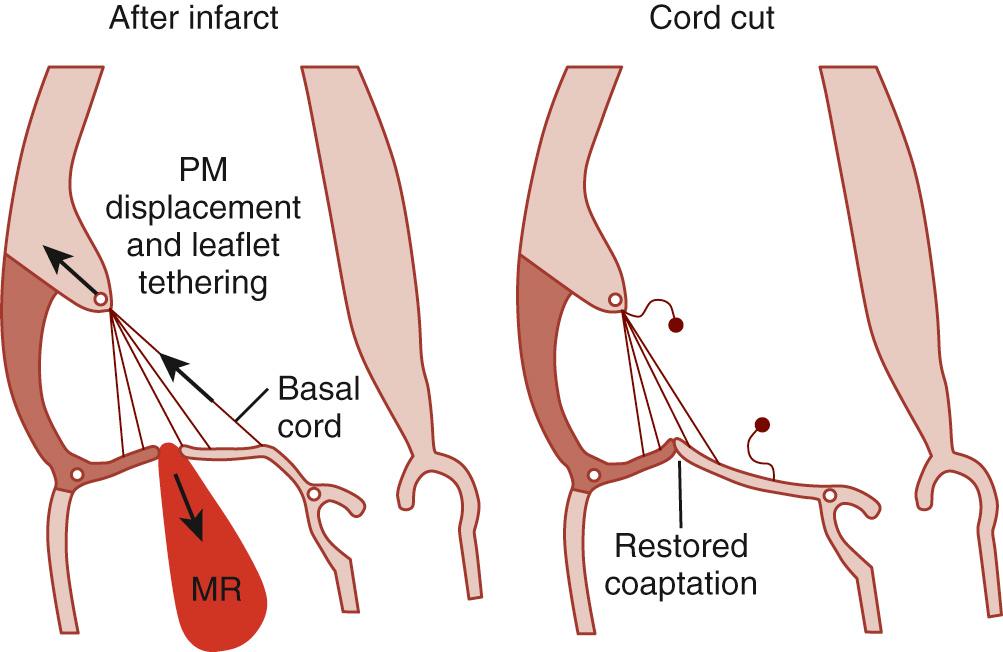
External devices designed to reduce tethering by displacing infarcted ventricle have also been investigated. Hung and colleagues used animal studies to evaluate an external device that works by displacing the infarcted ventricular wall that supported the tethered papillary muscle toward the mitral annulus. Use of this device should reduce tethering and resultant regurgitation ( Fig. 92-6 ).
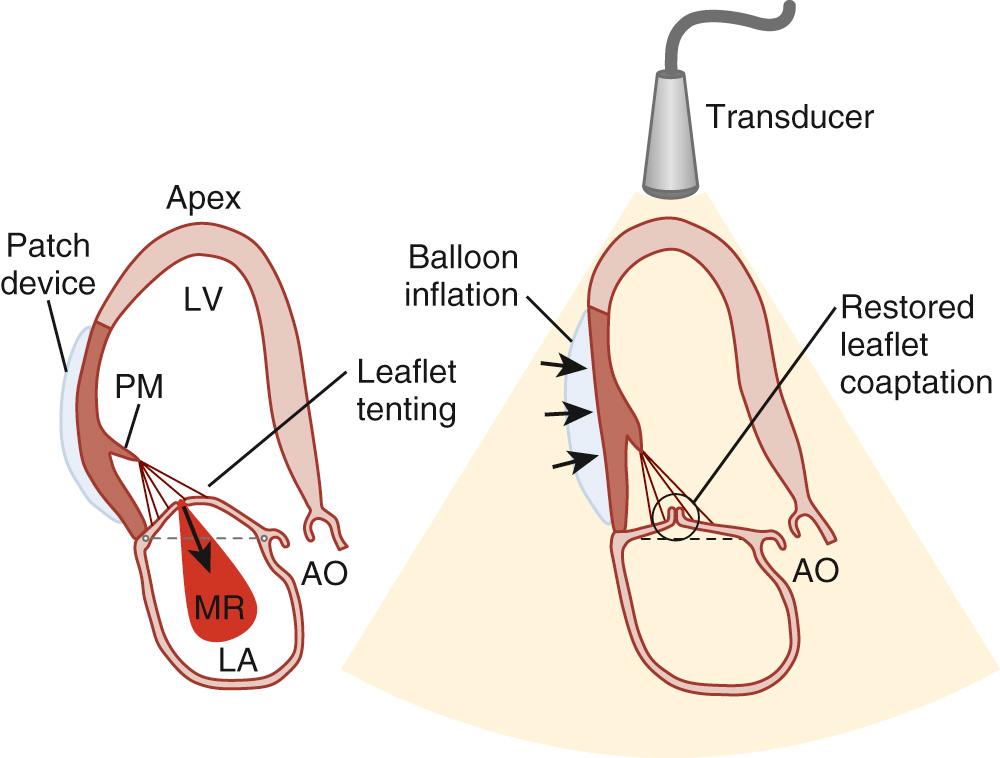
Because the leaflets are not directly involved in the causation of ischemic mitral regurgitation, there is limited scope for surgical intervention on the leaflets. Clefts tend to open up with leaflet tethering, and they may be closed at the time of mitral valve repair. The edge-to-edge leaflet technique has been proposed as an adjunct to annuloplasty, but alone it is not as effective a treatment for ischemic mitral regurgitation compared with annuloplasty. The edge-to-edge approach, however, is increasingly used with the percutaneous clip technique in patients who are not surgical candidates. There have been techniques for patch augmentation of both the anterior and posterior leaflet with acceptable early results; however, they may be technically challenging.
Operations to restore left ventricular geometry can reduce papillary muscle displacement and result in reduction of mitral regurgitation. This could be achieved by ventricular remodeling procedures (such as the Dor operation) or by localized plication of a lateral wall infarct. Approaches that halt the process of continued ventricular remodeling can improve durability of ischemic mitral valve repair by limiting further papillary muscle displacement. For example, external ventricular restraint devices wrapped round the ventricle at the time of mitral valve repair have been shown to limit future dilation of the left ventricle ; this eliminates one of the key pathophysiologic mechanisms for recurrent regurgitation after mitral annuloplasty (progressive ventricular remodeling). Injection of polymers into infarcted tissue has been explored experimentally by Hung and colleagues, who demonstrated that polymer injection supported the infarcted ventricle and stabilized the papillary muscles, thereby resulting in acute reverse remodeling of the ventricle and reduction in papillary muscle displacement and decrease in mitral regurgitation. Finally, injection of myoblasts or stem cells into infarcted tissue is another potential use of the left ventricle as a target, as this could theoretically reduce mitral regurgitation by restoring ventricular function and therefore reducing tethering.
The Coapsys device (Myocor, Inc., Maple Grove, MN) was an external compression device, placed without cardiopulmonary bypass, with an intracavitary cord that reshapes the left ventricle. By reshaping the ventricle, Coapsys compressed the mitral annulus and subvalvular apparatus and has been shown to decrease ischemic mitral regurgitation in animal studies. The RESTOR-MV trial randomized 149 patients with ischemic mitral regurgitation to CABG and conventional on-pump mitral valve repair or CABG with off-pump Coapsys implantation, and it found better survival and fewer adverse events in the Coapsys arm compared with standard surgical repair. Unfortunately, the RESTOR-MV study was closed prematurely because of corporate financial issues, and the device did not achieve clinical approval, but the study is a useful demonstration that ventricular reshaping may be effective in ischemic mitral regurgitation.
Preoperative decision making in ischemic mitral regurgitation is complex and challenging. The clinical literature is often contradictory, making it difficult to synthesize and distill the information into concrete and practical clinical recommendations. Many factors must be considered in decision making, including the specific clinical scenario, the negative effects of ischemic mitral regurgitation on medium-term survival, the challenge of the intraoperative assessment of mitral regurgitation severity, the effects of coronary artery bypass grafting (CABG) alone on mitral regurgitation severity, the effects of CABG with or without mitral surgery on survival and late functional status, the additional operative risk of mitral valve surgery at the time of CABG, and the choice of valve repair versus replacement. We believe that the cumulative evidence and experience about these various issues are coalescing into a set of principles that can guide modern surgical decision making for the treatment of this disease ( Fig. 92-7 ).
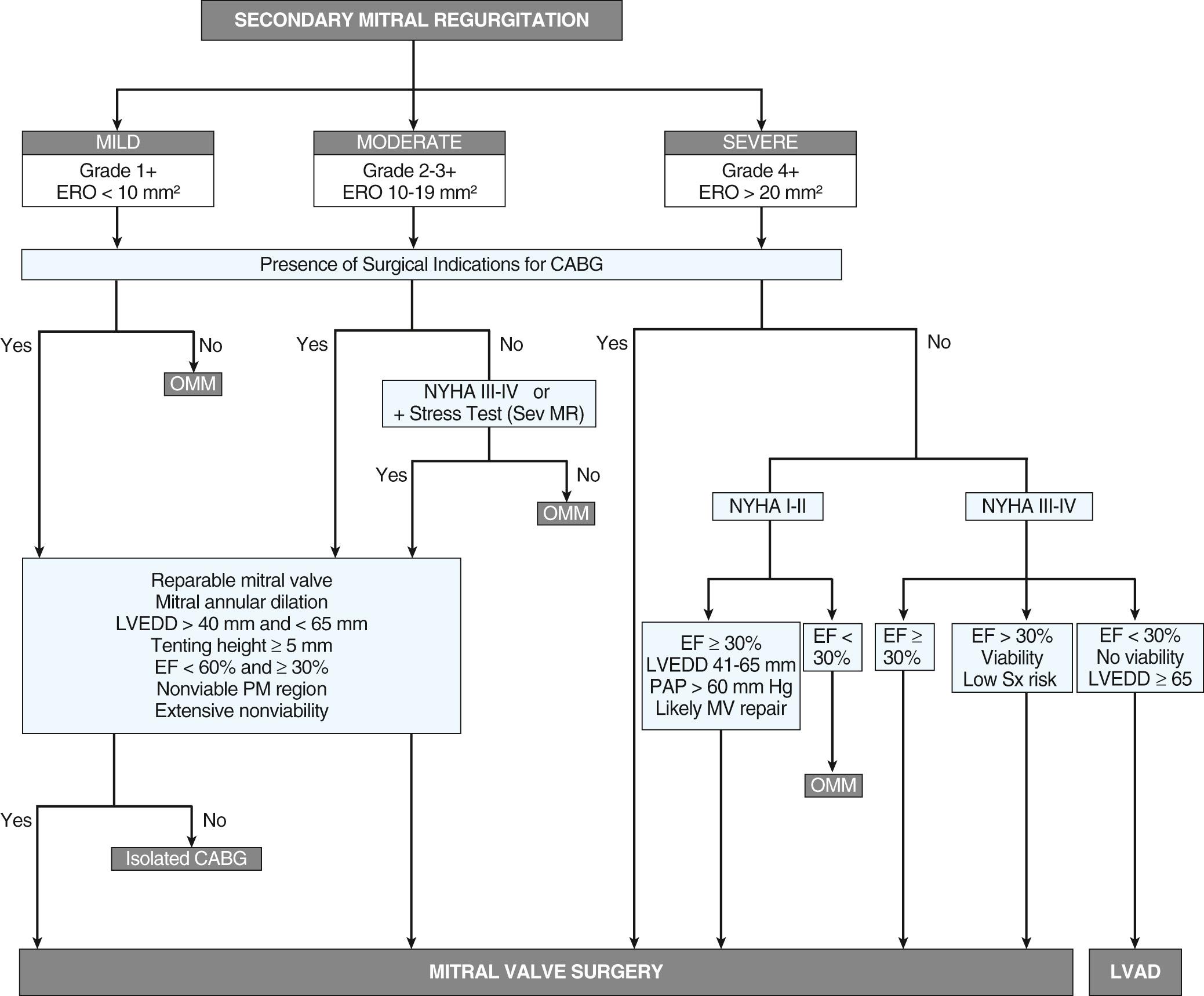
Patients with severe mitral regurgitation, symptoms of congestive heart failure, or worsening left ventricular function are referred primarily for mitral valve surgery (as opposed to referred for coronary revascularization). The preoperative coronary angiogram typically shows significant coronary artery disease that may or may not have been symptomatic with angina. Patients may have undergone prior surgical or percutaneous revascularization. These patients typically have evidence of prior myocardial infarction and moderate or severe left ventricular dysfunction. They can be viewed as ischemic cardiomyopathy with associated mitral regurgitation.
It must be stressed that in all these patients the initial therapy is guideline directed heart failure medical management. Medical therapy aims to maintain euvolemia and to reduce cardiac preload and afterload thereby optimizing cardiac performance. In many patients, medical management will result in reduction of severity of regurgitation, with varying degrees of symptom improvement. Medical therapy includes maximally tolerated doses of diuretics, angiotensin converting enzyme inhibitors or angiotensin receptor antagonists, aldosterone antagonists, and beta blockers, especially carvedilol. Cardiac resynchronization therapy (CRT) with biventricular pacing should be used in patients with severe ischemic mitral regurgitation who show evidence of dyssynchrony. Responders to CRT have been shown to have significant reduction in severity of secondary mitral regurgitation. Consideration for mitral valve surgery for severe ischemic regurgitation in the heart failure patient without primary indication for CABG should, therefore, be undertaken only after confirmation that medical therapy is optimal and CRT has been attempted or is not indicated. In general, surgical therapies are not considered, even if regurgitation remains severe on medical therapy, unless symptoms remain severe (New York Heart Association [NYHA] class III or IV). In selected low-risk patients, however, mitral valve surgery can be considered in NYHA II patients where the ventricle is not severely dysfunctional or remodeled with the hope that intervention can delay or prevent further negative remodeling. (Although there is no direct evidence to support this, randomized trials seem to show reverse left ventricular remodeling at 12 months in patients with moderate mitral regurgitation who undergo mitral valve repair. )
Patients who remain severely symptomatic (NYHA III or IV) despite medical therapy, and who have an ejection fraction over 30%, should be offered mitral valve surgery as the risk is acceptable (provided no major comorbidity) and patients can expect substantial improvement in symptoms. If the ejection fraction is particularly low (<30%), the decision to operate, in the absence of documented ischemia, is similar to the decision that needs to be made for patients with mitral regurgitation as a result of nonischemic cardiomyopathy. Patients with severe ischemic mitral regurgitation with symptoms of congestive heart failure or worsening left ventricular function (or both) can undergo combined mitral valve surgery and CABG as long as the expected operative morbidity and mortality is not prohibitive. For patients who survive and recover from surgery, the expected benefit of surgery would be better control of heart failure with likely improvement of symptoms. However, there is no clear evidence that life expectancy is improved by mitral valve repair in the setting of left ventricular dysfunction, and indeed some data suggest the contrary. For this reason, advanced therapies for cardiac replacement (transplantation and left ventricular assist device implantation) have been used increasingly as options for treating ischemic mitral regurgitation in the severely dysfunctional and remodeled left ventricle (left ventricular end-diastolic diameter [LVEDD] > 65 mm), particularly where there is limited viability. Young patients with ischemic mitral regurgitation and severe left ventricular dysfunction, with NYHA class III or IV heart failure, should be screened to determine whether they meet indications and criteria for heart transplantation before undertaking mitral valve surgery. Some patients with advanced ischemic cardiomyopathy and ischemic mitral regurgitation, who are not candidates for transplantation, may be suitable for destination left ventricular assist device as an alternative to high risk mitral valve surgery.
An increasingly common scenario is severe mitral regurgitation seen in patients who have undergone prior CABG. Often, this regurgitation had not been addressed at the CABG procedure and has since progressed. These patients present unique challenge because reoperation in the presence of patent coronary bypass grafts may increase operative risk. Thoughtful consideration for appropriate patient selection and operative strategy is warranted. Reoperative surgery to address ischemic mitral regurgitation is generally recommended only when quality of life is greatly impaired, despite optimal medical therapy (NYHA III or IV).
The other common clinical scenario is that of a patient with symptomatic coronary artery disease who is referred for CABG and who is noted to have mild or moderate mitral regurgitation on preoperative or intraoperative echocardiography. Although the patient may have shortness of breath—as an angina equivalent or symptoms or signs of congestive heart failure (sometimes recognized in retrospect)—myocardial ischemia (an acute coronary syndrome or chronic stable angina) usually dominates the clinical picture and is the primary indication for surgical intervention.
Mild mitral regurgitation usually does not need to be addressed at the time of revascularization. If there are indications that the mild regurgitation might not run a benign course (e.g., left ventricular enlargement, substantial infarction or nonviability, pulmonary hypertension, excessive leaflet tenting), then it should be managed as moderate regurgitation.
Although most surgeons agree that severe mitral regurgitation should be corrected at the time of CABG, irrespective of the presenting symptoms, the optimal management of moderate ischemic mitral regurgitation remains controversial. One school of thought favors an aggressive repair strategy for moderate regurgitation, and another is more conservative.
Those favoring a conservative approach argue as follows:
Revascularizing ischemic areas will improve regional wall motion and reduce the mitral regurgitation. This benefit of CABG on ischemic mitral regurgitation is seen most in patients who have viable myocardium in the area of revascularization and in patients who do not have dyssynchrony of the papillary muscles.
Some historical studies suggested that performing CABG alone does not have a negative effect on long-term survival or functional status, even if some residual mitral regurgitation persists.
Mitral valve surgery adds significantly to the operative risk of CABG, with several historical and contemporary series reporting operative mortalities in excess of 10% with combined procedures.
Patients with moderate ischemic mitral regurgitation tend to have relatively small left atria, thereby making mitral valve exposure and repair more difficult.
Mitral valve replacement, if it is necessary, carries the potential burden of prosthesis-related morbidity.
Many other surgeons, however, advocate the more liberal application of mitral valve surgery in patients with moderate ischemic mitral regurgitation undergoing CABG, arguing the following:
Chronic ischemic mitral regurgitation is a dynamic condition that is highly dependent on preload and afterload. The preoperative echocardiogram merely represents a brief snapshot of the severity of mitral regurgitation at the time of the study. The fact that many patients with “moderate” mitral regurgitation, or less, present with symptoms of congestive heart failure or enlarged left atria suggests that they probably have frequent episodes of more severe mitral regurgitation.
CABG alone does not correct moderate ischemic mitral regurgitation in many patients, especially those with scarring from myocardial infarction and those with annular and ventricular dilation. Patients who do not have viable or hibernating myocardium are less likely to benefit from revascularization alone.
Significant residual ischemic mitral regurgitation can, according to several studies, result in late symptoms and decreased long-term survival (discussed later).
Mitral annuloplasty is usually technically feasible, and almost always corrects moderate ischemic mitral regurgitation, thereby making mitral valve replacement usually unnecessary (unless the specific preference of the surgeon).
The high operative mortality for combined mitral valve surgery and CABG reported in the literature is outdated and reflects a significant number of patients undergoing mitral valve replacement. Mitral valve repair in the modern era can be performed at the time of CABG, with an operative mortality as low as 2% to 4%.
Leaving significant residual mitral regurgitation exposes the patient to a potential need for reoperative mitral valve surgery in the presence of patent coronary grafts, which carries substantial operative risk.
Two randomized studies have evaluated the role for mitral valve annuloplasty in moderate ischemic mitral regurgitation. Fattouch and colleagues randomized 102 patients to CABG alone or CABG with mitral annuloplasty. This study demonstrated an improvement in NYHA class and a reversal in left ventricular remodeling with the addition of mitral annuloplasty to CABG, but it did not demonstrate a survival advantage. More recently the RIME investigators randomized 73 patients undergoing CABG with moderate ischemic mitral regurgitation to CABG alone or CABG and mitral annuloplasty. Compared with patients who had CABG alone, at 12 months patients who had a concurrent mitral valve annuloplasty had superior functional status measured by both the NYHA class and by peak oxygen consumption. Left ventricular reverse remodeling was also greater in patients who had concurrent mitral valve repair.
The summation of best available evidence is in favor of intervening on moderate degrees of regurgitation at the time of CABG, mainly because of benefit in long-term functional status and left ventricular reverse remodeling. Concurrent mitral annuloplasty should therefore be considered in all patients having coronary artery bypass surgery who have documented moderate or greater mitral regurgitation, unless specific operative or patient-related factors suggest a need for a limited or expeditious operation, or if there is strong basis to believe the mitral regurgitation can reverse with revascularization alone (e.g., good global ventricular function with extensive viability and limited infarction). The recommended surgical intervention for moderate ischemic regurgitation is mitral annuloplasty, as this has been demonstrated in randomized trials to be effective (compared with CABG alone). The efficacy and safety of mitral valve replacement has not been evaluated in the setting of moderate mitral valve regurgitation.
Become a Clinical Tree membership for Full access and enjoy Unlimited articles
If you are a member. Log in here